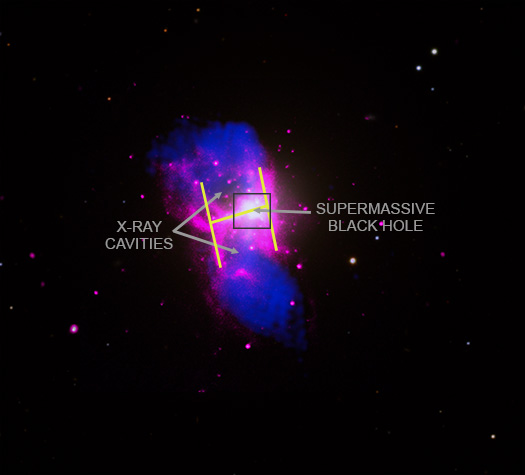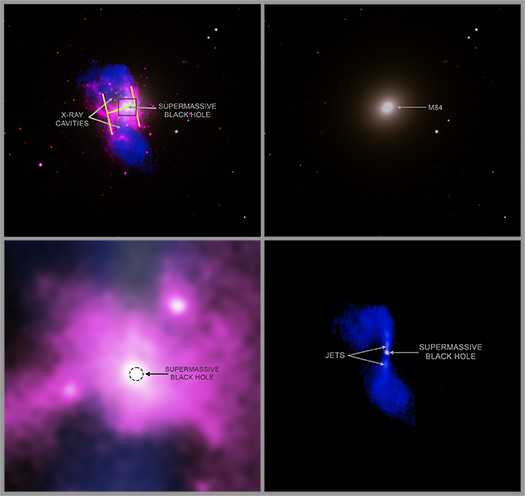With a single letter seemingly etched in the X-ray glow around it, a giant black hole at the center of a massive elliptical galaxy is making a mark on its surroundings.
This “H”-shaped structure is found in a detailed new X-ray map of the multimillion-degree gas around the galaxy Messier 84 (M84).
As gas is captured by the gravitational force of the black hole, some of it will fall into the abyss, never to be seen again. Some of the gas, however, avoids this fate and instead gets blasted away from the black hole in the form of jets of particles. These jets can push out cavities, in the hot gas surrounding the black hole. Given the orientation of the jets to Earth and the profile of the hot gas, the cavities in M84 form what appears to resemble the letter “H.” The H-shaped structure in the gas is an example of pareidolia, which is when people see familiar shapes or patterns in random data. Pareidolia can occur in all kinds of data from clouds to rocks and astronomical images.

Astronomers used NASA’s Chandra X-ray Observatory to make a map of the hot gas (pink) in and around M84, reaching to within only about 100 light-years away from the black hole in the center of the galaxy. This gas radiates at temperatures in the tens of millions of degrees, making it primarily observable in X-rays. The huge letter “H” is about 40,000 light-years tall — about half the width of the Milky Way. The radio image from the National Science Foundation’s Karl G. Jansky Very Large Array (VLA) (blue) reveals the jets streaking away from the black hole. Optical data from the Sloan Digital Sky Survey (white) shows M84 and neighboring galaxies. The letter H and the position of the black hole are labeled. An additional graphic shows a close-up of the region marked with a square, and separate labels for the galaxy and the jets in the optical and radio images respectively.

Researchers studying M84 with Chandra and the VLA found that the jets may influence the flow of the hot gas towards the black hole even more than the gravitational pull from the black hole. For example, the team estimates matter is falling towards the black hole from the north — along the direction of the jet seen in radio waves — at about 500 times the mass of the Earth every year, a rate that is only a quarter of that from directions where the jet is not pointing, to the east and west. One possibility is that gas is lifted along the direction of the jet by the cavities, slowing the rate at which gas falls onto the black hole.
The authors tested a model called Bondi accretion, where all of the matter within a certain distance from a black hole — effectively inside a sphere — is close enough to be affected by a black hole’s gravity and start falling inwards at the same rate from all directions. (The dashed circle in the close-up image is centered on the black hole and shows the approximate distance from the black hole where gas should start falling inwards.) This effect is named after the scientist Hermann Bondi, and “accretion” refers to matter falling toward the black hole. The new results show that Bondi accretion is not occurring in M84 because matter is not falling towards the black hole evenly from all directions.
M84 is a cousin of Messier 87 (M87), the galaxy containing the first black hole imaged with the global Event Horizon Telescope network, and, like M87, is also a member of the Virgo Cluster. The supermassive black hole in M84, along with those in our galaxy, M87, NGC 3115, and NGC 1600, are the only ones close enough to Earth, or massive enough, for astronomers to see details in Chandra images which are so near the black hole that gas should be falling inwards. Like the black hole in M87, the one in M84 is producing a jet of particles; however, the point source of X-rays from material even closer to the black hole is over ten times fainter for M84. This allows more detailed study of gas falling towards the black hole in M84 that is farther out, preventing the faint X-rays produced by this gas from being overwhelmed by the X-ray glare from the point source.
A paper describing these results appears in The Monthly Notices of the Royal Astronomical Society and a preprint is available here. The study was led by Christopher Bambic, a graduate student at Princeton University. Other authors include Helen Russell (University of Nottingham, United Kingdom), Christopher Reynolds (Institute of Astronomy, Cambridge, UK; University of Maryland, College Park), Andy Fabian (Institute of Astronomy), Brian McNamara (University of Waterloo, Canada; Waterloo Centre for Astrophysics, Canada), and Paul Nulsen (Center for Astrophysics | Harvard & Smithsonian).
NASA's Marshall Space Flight Center manages the Chandra program. The Smithsonian Astrophysical Observatory's Chandra X-ray Center controls science operations from Cambridge, Massachusetts, and flight operations from Burlington, Massachusetts.
This composite visualization combines X-ray, radio and optical images of hot gas, jets of particles, and a galaxy with an unseen black hole. Improbably, the resulting visual resembles a neon pink uppercase 'H' with a white splotch on the crossbar, leaning back against a vertical, neon blue pillow, floating in the blackness of space.
The white splotch on the cross bar is the galaxy Messier 84. The neon pink found in the uppercase H shape represents multimillion degree gas. The neon blue in the pillow behind it represents jets of particles produced by the unseen black hole at the center of the galaxy.
Here, two neon blue jets blast away from the bright white galaxy, M84. One aims up, the other aims down. The ends of the blue jets have created the look of a vertical, lumpy blue pillow. These powerful jets have pushed out the clouds of hot gas that surround the black hole in the center of M84. The holes they created leave the pink gas resembling an uppercase 'H'. The crossbar is what remains at the center of the neon pink cloud, surrounding the brilliant white galaxy at its core.
Specks of gas rendered in neon pink dot the black background, like spatter from an artist’s brush. Around the outside of the image, other galaxies are seen in white.
|
||||||||||||||||||||||||||||||||


